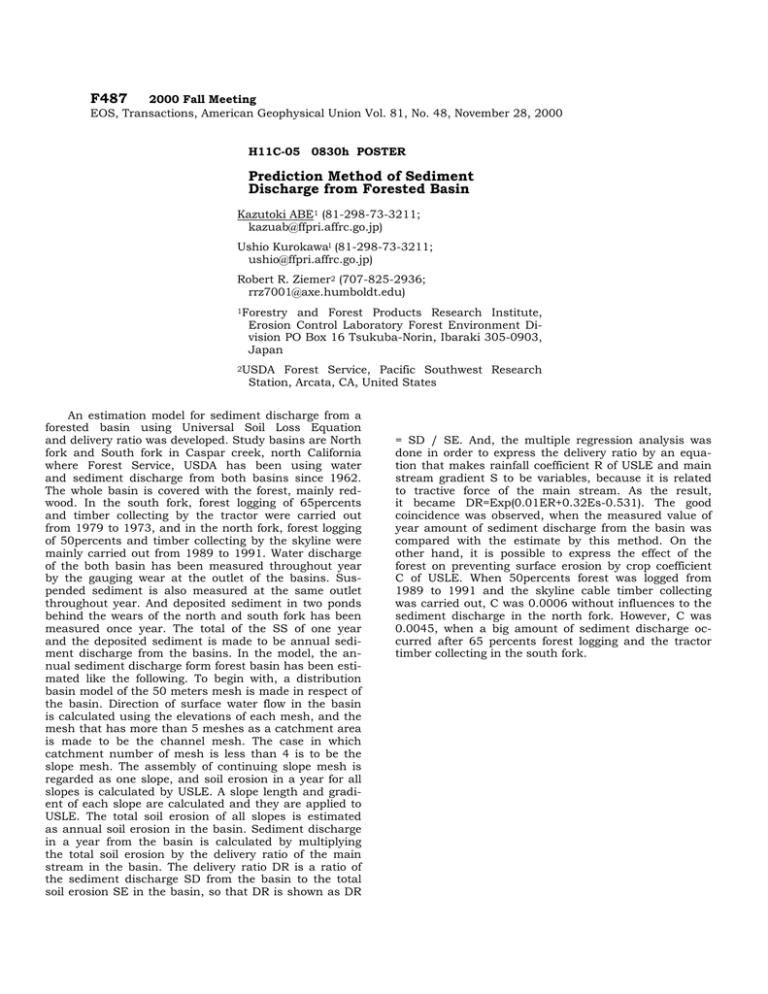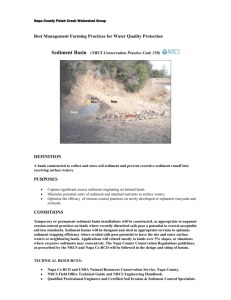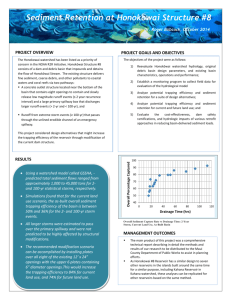F487 Prediction Method of Sediment Discharge from Forested Basin
advertisement

F487 2000 Fall Meeting EOS, Transactions, American Geophysical Union Vol. 81, No. 48, November 28, 2000 H11C-05 0830h POSTER Prediction Method of Sediment Discharge from Forested Basin Kazutoki ABE1 (81-298-73-3211; kazuab@ffpri.affrc.go.jp) Ushio Kurokawal (81-298-73-3211; ushio@ffpri.affrc.go.jp) Robert R. Ziemer2 (707-825-2936; rrz7001@axe.humboldt.edu) 1Forestry and Forest Products Research Institute, Erosion Control Laboratory Forest Environment Division PO Box 16 Tsukuba-Norin, Ibaraki 305-0903, Japan 2USDA Forest Service, Pacific Southwest Research Station, Arcata, CA, United States An estimation model for sediment discharge from a forested basin using Universal Soil Loss Equation and delivery ratio was developed. Study basins are North fork and South fork in Caspar creek, north California where Forest Service, USDA has been using water and sediment discharge from both basins since 1962. The whole basin is covered with the forest, mainly redwood. In the south fork, forest logging of 65percents and timber collecting by the tractor were carried out from 1979 to 1973, and in the north fork, forest logging of 50percents and timber collecting by the skyline were mainly carried out from 1989 to 1991. Water discharge of the both basin has been measured throughout year by the gauging wear at the outlet of the basins. Suspended sediment is also measured at the same outlet throughout year. And deposited sediment in two ponds behind the wears of the north and south fork has been measured once year. The total of the SS of one year and the deposited sediment is made to be annual sediment discharge from the basins. In the model, the annual sediment discharge form forest basin has been estimated like the following. To begin with, a distribution basin model of the 50 meters mesh is made in respect of the basin. Direction of surface water flow in the basin is calculated using the elevations of each mesh, and the mesh that has more than 5 meshes as a catchment area is made to be the channel mesh. The case in which catchment number of mesh is less than 4 is to be the slope mesh. The assembly of continuing slope mesh is regarded as one slope, and soil erosion in a year for all slopes is calculated by USLE. A slope length and gradient of each slope are calculated and they are applied to USLE. The total soil erosion of all slopes is estimated as annual soil erosion in the basin. Sediment discharge in a year from the basin is calculated by multiplying the total soil erosion by the delivery ratio of the main stream in the basin. The delivery ratio DR is a ratio of the sediment discharge SD from the basin to the total soil erosion SE in the basin, so that DR is shown as DR = SD / SE. And, the multiple regression analysis was done in order to express the delivery ratio by an equation that makes rainfall coefficient R of USLE and main stream gradient S to be variables, because it is related to tractive force of the main stream. As the result, it became DR=Exp(0.01ER+0.32Es-0.531). The good coincidence was observed, when the measured value of year amount of sediment discharge from the basin was compared with the estimate by this method. On the other hand, it is possible to express the effect of the forest on preventing surface erosion by crop coefficient C of USLE. When 50percents forest was logged from 1989 to 1991 and the skyline cable timber collecting was carried out, C was 0.0006 without influences to the sediment discharge in the north fork. However, C was 0.0045, when a big amount of sediment discharge occurred after 65 percents forest logging and the tractor timber collecting in the south fork.




